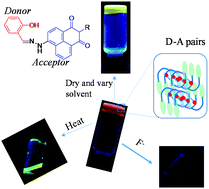Tunable multicolor emissions in a monocomponent gel system by varying the solvent, temperature and fluoride anion†
Abstract
The facile tuning of the fluorescent properties of organogels is highly desirable for optical switches, light-emitting diodes, chemosensors and bioprobes. The design of organic molecules with multiple emission colors but only one molecular platform remains challenging. Herein, a new cholesterol-based organogelator N1 containing D–A pairs (salicylaldehyde and naphthalimide units) was designed. We successfully obtained multiple solvent-tuned emission colors in both the solution and gel states using a unimolecular platform. Moreover, the effects of the solvent on the gel morphology, rheology and anion-responsive properties were studied. Finally, we showed that the gel in benzene displayed reversible thermochromic properties with changes in emission color from yellow-green to red. Several experiments suggested that a short-distance and ordered array of the D–A pairs facilitated the efficient intermolecular electron transfer of the fluorophores.


 Please wait while we load your content...
Please wait while we load your content...